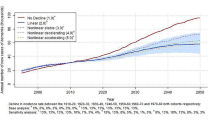Abstract
Background: The epidemiology of a disease describes numbers of people becoming incident, being prevalent, recovering, surviving, and dying from the disease or from other causes. As a matter of accounting principle, the inflow, stock, and outflows must be compatible, and if we could observe completely every person involved, the epidemiologic estimates describing the disease would be consistent. Lack of consistency is an indicator for possible measurement error. Methods: We examined the consistency of estimates of incidence, prevalence, and excess mortality of dementia from the Rotterdam Study. We used the incidence and excess mortality estimates to calculate with a mathematical disease model a predicted prevalence, and compared the predicted to the observed prevalence. Results: Predicted prevalence is in most age groups lower than observed, and the difference between them is significant for some age groups. Conclusions: The observed discrepancy could be due to overestimates of prevalence or excess mortality, or an underestimate of incidence, or a combination of all three. We conclude from an analysis of possible causes that it is not possible to say which contributes most to the discrepancy. Estimating dementia incidence in an aging cohort presents a dilemma: with a short follow-up border-line incident cases are easily missed, and with longer follow-up measurement problems increase due to the associated aging of the cohort. Checking for consistency is a useful strategy to signal possible measurement error, but some sources of error may be impossible to avoid.
Similar content being viewed by others
Abbreviations
- CI:
-
Confidence interval
- WHO:
-
World health organization
References
J Blanchard S Ludwig A Wadja et al. (1996) ArticleTitleIncidence and prevalence of diabetes in Manitoba, 1986–1991 Diabetes Care 19 807–811 Occurrence Handle8842595
C Leibson L Milton PJ Palumbo (1997) ArticleTitleTemporal trends in Diabetes incidence and prevalence [Letter] Diabetes Care 20 IssueID3 460–461
A Ott MM Breteler F Harskamp Particlevan et al. (1995) ArticleTitlePrevalence of Alzheimer’s disease and vascular dementia: Association with education. The Rotterdam study Br Med J 310 IssueID6985 970–973
E Witthaus A Ott JJ Barendregt M Breteler L Bonneux (1999) ArticleTitleBurden of mortality and morbidity from dementia Alz Dis Assoc Dis 13 IssueID3 176–181
C Radhakrrishna Rao (1973) Linear Statistical Inference and its Applications EditionNumber2nd edns. Wiley New York
A Ruitenberg A Ott JC Swieten Particlevan A Hofman MM Breteler (2001) ArticleTitleIncidence of dementia: Does gender make a difference? Neurobiol Aging 22 IssueID4 575–580 Occurrence Handle10.1016/S0197-4580(01)00231-7 Occurrence Handle11445258
JJ Barendregt GJ Oortmarssen Particlevan T Vos CJL Murray (2003) ArticleTitleA generic model for the assessment of disease epidemiology: The computational basis of DisMod II Population Health Metr 1 IssueID1 4 Occurrence Handle10.1186/1478-7954-1-4
WH Press SA Teukolsky WT Vetterling BP Flannery (1992) Numerical Recipes in Fortran 77: The Art of Scientific Computing Cambridge Cambridge University press
B Efron RJ Tibshirani (1993) An Introduction to the Bootstrap Chapman & Hall Inc London
ME Kruijshaar JJ Barendregt N Hoeymans (2002) ArticleTitleThe use of models in the estimation of disease epidemiology Bull WHO 80 IssueID8 622–628 Occurrence Handle12219152
A Ott (1997) Risk of dementia. The Rotterdam Study, PhD thesis Rotterdam Erasmus University
A Ott MM Breteler F Harskamp Particlevan T Stijnen A Hofman (1998) ArticleTitleIncidence and risk of dementia. The Rotterdam Study Am J Epidemiol 147 IssueID6 574–580 Occurrence Handle9521184
Author information
Authors and Affiliations
Corresponding author
Rights and permissions
About this article
Cite this article
Barendregt, J.J., Ott, A. Consistency of Epidemiologic Estimates. Eur J Epidemiol 20, 827–832 (2005). https://doi.org/10.1007/s10654-005-2227-9
Accepted:
Issue Date:
DOI: https://doi.org/10.1007/s10654-005-2227-9




